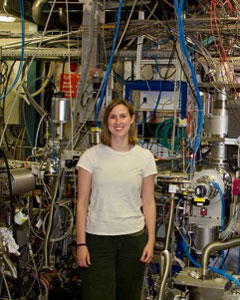
(she/her), Switzerland
LinkedIn: linkedin.com/in/emma-kate-anderson-phd-105942165/
I was born and raised in Sydney and moved to Canberra to study physics and chemistry at the Australian National University (ANU) where I completed honours researching positron interactions with biomolecules. After graduation I went on a long-awaited holiday, backpacking in Europe! Whilst travelling I arranged to meet several professors who were doing research that I was deeply interested in.
I had decided I wanted to do a PhD, but I hadn’t seriously considered going overseas and I lacked the confidence to apply to top institutions abroad. I was given some sorely needed encouragement from a mentor which spurred me to apply for exciting research positions in locations I thought I would enjoy – I’ve found having mentors to be extremely valuable. I wanted a new cultural experience but to be somewhere I could navigate life’s essentials (like a doctor’s visit) in English.
Ultimately, I joined the Atomic Physics Division at Stockholm University, where I completed my PhD over five years with a 20% teaching load (a four-year option is available). I got to do exciting and challenging research with a world-unique apparatus studying molecule/cluster ions stored in an extreme high vacuum of 10 millionths of a billionth (10-17) of atmospheric pressure, only possible due to the cryogenic environment (~13 K).
I had a wonderful experience, made amazing friends and met my husband, an Australian-Swede. I continued at Stockholm University beyond my PhD as a post-doc and was pregnant by the time my contract came to an end. My son arrived soon after, during the early pandemic.
I took a break to look after my son, and then my family and I moved to Geneva so I could take up a post-doc position with Aarhus University, which posted me to CERN to work with the ALPHA collaboration. ALPHA is conducting experiments with trapped anti-hydrogen, the only place in the world this is possible. By comparing hydrogen and anti-hydrogen precisely, we can learn about the fundamental symmetries between matter and antimatter.
While I’ve found the work at CERN to be interesting and challenging, I’m now coming to the end of my time there and making plans for the next step. I don’t know what it is yet, but I’m sure it will be its own adventure.

The greatest challenge is settling in, navigating new systems for housing, banking and healthcare. As life gets more complicated with a partner and family there’s more to navigate, balancing the needs of a second career and childcare/schooling. There is often little-to-no concrete assistance provided by your institution. It is both time consuming and expensive to move!
Short-term contracts also pose challenges. Your visa (and your family’s) may depend on your contract. Short-term contracts also make obtaining maternity leave difficult in practice. Sweden was more generous than other countries here, in that the government rather than the employer provides a base level of paid leave, but it’s still a financial hit.
There are wonderful benefits to living in such a rich cultural environment. My two-year-old is trilingual, attending bilingual crèche (French/Swedish) and speaking English at home.
I’ve made wonderful friends, many who are also far from their home countries and families which strengthens the bonds of our friendship. We share our love of our home countries with each other; I’ve been part of their traditions and been welcomed to their families’ homes for Christmases and weddings. They expect to receive ANZAC biscuits once a year.
I’ve lived in beautiful places, very different to the beauty of Australia. This weekend I will go into the mountains of Switzerland to see the cows (crowned with flowers and bells around their necks) return from the mountain pastures for the winter.
Timing of the academic year in Europe doesn’t match Australia, so you need to think about applications and timing well in advance as many positions follow academic year funding rounds.
Don’t underestimate the quality of education and training in Australia – we’re quite competitive internationally. I found it easy to underestimate my own skills and overestimate those of people from prestigious overseas institutions.
Don’t be too afraid of language; yes there are challenges with working in a country with a differing language but there is often a lot of support and it’s amazing how you can muddle through.
The career opportunities can be excellent for researchers if you are willing to consider Europe as a whole. There are larger institutions, such as CERN, which host a range of important projects, meaning that there can be more career options allowing you to settle in one place for longer and give other parts of your life more time and space.
Work–life balance seems to depend a lot on the project and the institution, so ideally try to get a picture of that before settling on a position and try to be comfortable with the trade-off you’ve picked. More prestigious roles seem to come with heavier workloads and a poorer work–life balance. Sweden has a strong belief in a work–life balance and has universal parental leave and childcare, which is a tremendous safety-net for researchers who become parents.
© 2025 Australian Academy of Science